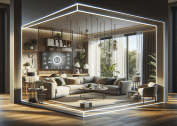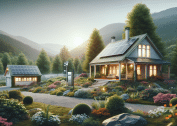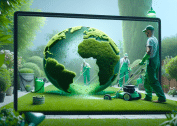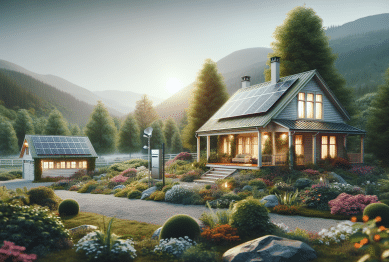Explore how practical design choices and unique garden upgrades can transform any living space. This engaging guide shares expert insights and current trends for refreshing your home and outdoor areas, from clever storage solutions to sustainable landscape ideas.
Making the Most of Small Spaces Indoors
Small homes create unique opportunities to maximize every corner. Clever storage solutions, such as multipurpose furniture and wall-mounted shelves, can make a room feel more spacious while keeping clutter at bay. Many find that foldable pieces bring flexibility into their lifestyle without sacrificing style or comfort. A dash of creativity, like using hidden compartments under seating, brings valuable organization while maintaining aesthetic appeal. Incorporating open shelving in kitchens or living areas offers accessible storage and display opportunities for both essentials and decorative items. For those wanting more from their floor space, consider investing in vertical garden panels or compact indoor planters to add a pop of nature and freshness.
Lighting plays a powerful role in influencing how open or confined a small interior feels. Natural light, when harnessed efficiently through window treatments and strategic use of mirrors, can make any space airier. Sheer curtains and reflective surfaces amplify light, which in turn broadens perceptions of space. LED lighting and under-cabinet fixtures provide extra brightness for work or reading areas, making them functional day and evening. Incorporating smart home lighting systems further enhances convenience, allowing easy adjustment of ambiance depending on activity or mood. Consider using neutral color palettes; light-colored walls, floors, and furnishings help bounce light and visually expand the area.
Many homeowners now experiment with flexible layouts. Moving away from the rigid separation of rooms, open-plan arrangements invite greater flexibility and a sense of freedom in compact homes. Sliding partitions or mobile storage units easily define spaces when privacy is needed and can be tucked away for gatherings. Modular furniture offers a solution for changing needs, as it can be reconfigured or moved across different rooms. An adaptable approach brings both efficiency and modern flair to small indoor environments. The combined effect of smart storage, strategic lighting, and layout flexibility can transform even the most modest interiors into welcoming, functional retreats.
Sustainable Materials and Eco-Friendly Updates
Eco-conscious design has become a driving force in home improvement. Choosing sustainable materials—such as bamboo flooring, recycled glass tiles, or salvaged wood—can refresh living spaces while reducing environmental impact. These materials are durable, stylish, and often provide a unique visual narrative. Many homeowners also switch to low-VOC paints, which help improve indoor air quality and support a healthier environment. Green home upgrades may include energy-efficient appliances and fixtures that lower utility bills while conserving resources. Investing in water-saving faucets, dual-flush toilets, and programmable thermostats creates long-term value as well as comfort.
Gardens are equally ripe for eco-friendly transformation. Rainwater harvesting systems, native plant landscaping, and composting bins are three popular components of a sustainable outdoor space. Native species are resilient, require less irrigation, and attract beneficial pollinators. Mulching garden beds further conserves soil moisture and cuts down on the need for synthetic fertilizers. Solar-powered garden lights illuminate paths and patios without adding to electrical expenses. Together, these updates benefit the environment and the household budget. Homeowners find the appeal of sustainable choices increasingly aligns with both personal values and long-term property investment strategies.
Recycling and upcycling have found a home in both interior and exterior design. Repurposed materials—such as turning old pallets into patio furniture or using reclaimed bricks for garden borders—encourage creativity and reduce waste. Many communities now offer grants or incentives for eco-friendly upgrades, from solar panel installations to energy audits. Choosing sustainable products and practices not only lessens ecological footprint but also fosters a deeper sense of accomplishment. A green approach to home and garden design is a rewarding journey, blending practicality, ethics, and style.
Creating Inviting Outdoor Living Spaces
Outdoor living has moved beyond the traditional patio or garden lawn. Today’s homeowners explore creative ways to extend the comforts of home into the backyard. Features like pergolas, weather-resistant lounges, and fire pits encourage gathering in open air while providing shelter and style. Outdoor kitchens, complete with prep counters and built-in grills, turn meals outside into memorable experiences. Thoughtful lighting—such as string lights or solar lanterns—softens the ambiance and adds character to al fresco dining or evening relaxation zones. Making the most of any outdoor area, regardless of size, is possible with good planning and adaptable furnishings.
Versatile outdoor spaces can serve multiple needs, from relaxation to entertainment and even remote work. Movable furniture and portable shade structures help transition a backyard from sunny retreat to nighttime social hub. Raised garden beds or vertical planters add privacy, define zones, and create lush backdrops. Water features, from simple fountains to pondless waterfalls, introduce soothing sounds and attract wildlife, further enhancing a sense of tranquility. When planning an outdoor living area, many find success by blending textures—wood, stone, metal—for visual depth. This variety makes spaces more engaging and comfortable for year-round use.
Gardening remains a staple of outdoor enjoyment. Container gardens suit balconies and patios, allowing for personalized arrangements of flowers, herbs, or even small fruits and vegetables. Edible landscapes combine beauty and practicality, giving homeowners access to fresh produce just steps from their door. Adding native perennials or pollinator-friendly plants brings biodiversity and seasonal interest. The fusion of social, culinary, and environmental functions in the garden highlights the evolving role of outdoor spaces. With a little creativity, any yard or balcony can flourish as an inviting extension of the home.
Maximizing Curb Appeal With Landscaping
Curb appeal is the first impression any home makes. Landscaping offers a powerful tool for instantly refreshing exterior charm. Well-maintained lawns, blooming flower beds, and defined pathways draw the eye and set a welcoming tone. Shrubs and trees, when selected and positioned thoughtfully, provide structure, shade, and year-round greenery. Simple upgrades, such as new house numbers or a painted front door, create visual contrast and personality without major renovations. Incorporating varied plant heights and colors enhances both interest and natural cohesion. In neighborhoods where front yards are prominent, low fencing or hedges establish gentle boundaries while inviting visitors in.
Low-maintenance landscaping solutions appeal to busy households. Groundcovers like creeping thyme or clover reduce mowing needs, while automated irrigation systems help them thrive with minimal effort. Drought-tolerant varieties—such as lavender, ornamental grasses, and succulents—remain vibrant in changing weather. Rock gardens, mulched beds, and native plant groupings ensure year-round curb appeal with little intervention. For those dealing with limited space or soil quality, raised planters and container gardens provide the same welcoming effect. Rethinking the entryway as a transition from public to private can inspire fresh ideas for both large and small plots.
Lighting and accessory choices further elevate curb appeal. Solar path lights or up-lighting for trees extend the enjoyment of gardens and showcase landscaping after sunset. Seasonal displays—like winter greenery, autumn pumpkins, or spring bulbs—keep the exterior inviting throughout the year. Outdoor art, seating, or bird feeders bring personality and interaction, transforming a simple yard into a space full of character and surprise. Maximizing the beauty and functionality of one’s front landscape supports property value while fostering neighborhood pride and personal satisfaction.
Trends in Home Organization and Decluttering
Decluttering remains an ongoing trend in home improvement, driven by the appeal of serenity and order. Minimalism encourages thoughtful selection of possessions and organized storage. Various strategies, from the KonMari Method to simple daily tidying routines, help maintain a calm environment. Built-in cabinets and underused spaces—such as attics or beneath stairs—often hold untapped potential for storage solutions. Bringing clarity to rooms starts with sorting belongings and letting go of items that no longer serve a purpose. The process may seem daunting but yields satisfying results for daily life.
Smart storage systems now feature prominently in both new builds and renovations. Drawer organizers, modular closet setups, and storage poufs double as seating or tables. For families, dedicated zones for mail, school items, and shoes reduce stress around household routines. Labeling containers and grouping similar items streamline cleaning and retrieval. Some embrace digital decluttering, organizing home offices and digital devices for efficiency. Tech-savvy solutions—like smart home hubs or organizational apps—bring harmony to both physical and virtual domains.
The benefits of a decluttered space go beyond aesthetics. Studies suggest that organized homes contribute to reduced stress, improved focus, and greater feelings of control and well-being (https://www.apa.org/monitor/2019/12/organize). Families often notice smoother routines, fewer lost items, and happier shared spaces. As decluttering continues to be celebrated in media and design circles, more resources—workshops, online challenges, and even community swap events—help homeowners refresh and maintain their living spaces with joy and confidence.
Smart Technology for Modern Homes and Gardens
Smart home technology has become integral to both comfort and efficiency. Devices like voice-activated assistants, smart thermostats, and automated blinds streamline daily routines and increase convenience. Security camera systems and video doorbells offer peace of mind by enabling instant monitoring. Many adopt smart irrigation systems for their gardens, which adjust watering schedules based on real-time weather data and plant needs. These tech-enhanced systems support sustainability and often lower utility bills through smarter resource use.
Energy management is a strong motivator for integrating smart technology. Advanced home energy monitors help pinpoint usage patterns and identify savings opportunities. Connected appliances, from refrigerators to washing machines, optimize cycles to match off-peak hours, reducing costs. Solar panels and battery storage solutions are now more accessible, bringing renewable energy into everyday life. Outdoor automation—including remote-controlled lighting, robotic lawnmowers, and WiFi-enabled garden irrigation—simplifies landscape maintenance and keeps gardens thriving with little ongoing effort.
As the smart home sector grows, homeowners are presented with a variety of interoperable options. Apps allow remote control over lighting, climate, and even plant care from anywhere. Smart sensors monitor conditions like humidity, soil fertility, and air quality, ensuring prompt responses and healthier environments. The integration of home and garden technologies shapes a new standard for living—one that balances ease, sustainability, and innovation (https://www.energy.gov/energysaver/smart-home-technologies).
References
1. U.S. Department of Energy. (n.d.). Smart Home Technologies. Retrieved from https://www.energy.gov/energysaver/smart-home-technologies
2. The National Gardening Association. (n.d.). Sustainable Gardening Practices. Retrieved from https://garden.org/learn/articles/view/5225/
3. Environmental Protection Agency. (n.d.). Green Home Solutions. Retrieved from https://www.epa.gov/greenhomes
4. American Psychological Association. (2019). Get organized to reduce stress. Retrieved from https://www.apa.org/monitor/2019/12/organize
5. National Renewable Energy Laboratory. (n.d.). Residential Solar Energy. Retrieved from https://www.nrel.gov/research/re-solar.html
6. Royal Horticultural Society. (n.d.). Upcycling in Your Garden. Retrieved from https://www.rhs.org.uk/garden-inspiration/upcycling-ideas









